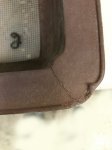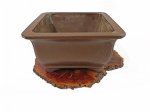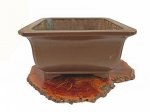fredtruck
Omono
Kintsugi is the Japanese art of gold joinery; that is, broken pottery is repaired by joining the pieces back together with resin and gold dust.
A few weeks ago, a straight-line wind clocked at over 100mph went through my back yard, destroying the few bonsai I had left outside. One of the victims was a square bonsai pot I am particularly fond of. It was cracked in diagonally opposed corners.
I inspected the damage.

This corner was the damaged the worst.

The crack ran deep down the side of the pot. As I worked on the pot, another crack became apparent, very close to the first and more visible one. I used an epoxy putty called EP-400. It sets up in 15 minutes or so and is incredibly hard.
I used a couple of different methods of finishing the putty. I employed very coarse sanding sticks, but eventually, I found that my Dremel rotary tool with a sanding cylinder run at 5,000 rpm was the best.

The parallel crack corner, above and below:

Laying the putty down.

Here, the finishing of the putty is partially complete. Next, the putty is completely smooth. Notice how the cracks almost completely disappear:

The single-crack corner is even less visible:

The Gold Leaf paint, applied:

In looking at Japanese examples of Kintsugi, I noticed there was an abstract expressionist feel to the way they laid the paint down. I followed their example feeling this type of brush work expressed the trauma of the pot being damaged.

Here is the less damaged side:

A few weeks ago, a straight-line wind clocked at over 100mph went through my back yard, destroying the few bonsai I had left outside. One of the victims was a square bonsai pot I am particularly fond of. It was cracked in diagonally opposed corners.
I inspected the damage.

This corner was the damaged the worst.

The crack ran deep down the side of the pot. As I worked on the pot, another crack became apparent, very close to the first and more visible one. I used an epoxy putty called EP-400. It sets up in 15 minutes or so and is incredibly hard.
I used a couple of different methods of finishing the putty. I employed very coarse sanding sticks, but eventually, I found that my Dremel rotary tool with a sanding cylinder run at 5,000 rpm was the best.

The parallel crack corner, above and below:

Laying the putty down.

Here, the finishing of the putty is partially complete. Next, the putty is completely smooth. Notice how the cracks almost completely disappear:

The single-crack corner is even less visible:

The Gold Leaf paint, applied:

In looking at Japanese examples of Kintsugi, I noticed there was an abstract expressionist feel to the way they laid the paint down. I followed their example feeling this type of brush work expressed the trauma of the pot being damaged.

Here is the less damaged side:



